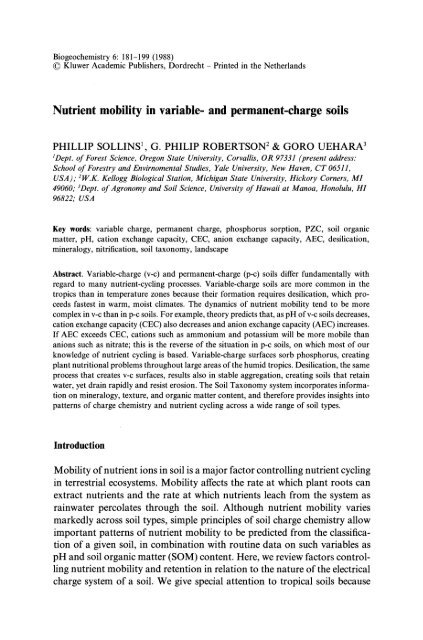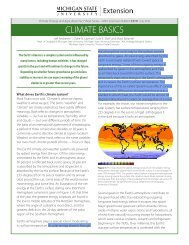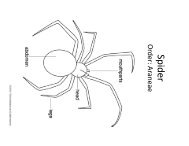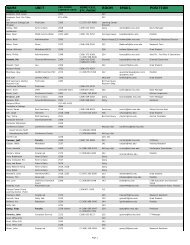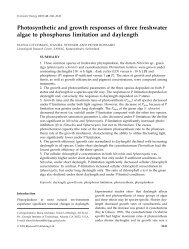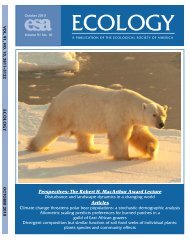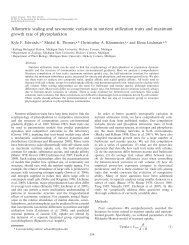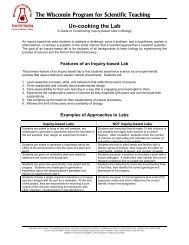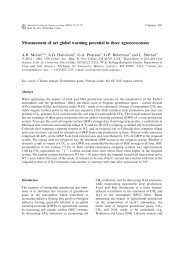Nutrient mobility in variable- and permanent-charge soils
Nutrient mobility in variable- and permanent-charge soils
Nutrient mobility in variable- and permanent-charge soils
Create successful ePaper yourself
Turn your PDF publications into a flip-book with our unique Google optimized e-Paper software.
Biogeochemistry 6: 181-199 (1988)? Kluwer Academic Publishers, Dordrecht - Pr<strong>in</strong>ted <strong>in</strong> the Netherl<strong>and</strong>s<strong>Nutrient</strong> <strong>mobility</strong> <strong>in</strong> <strong>variable</strong>- <strong>and</strong> <strong>permanent</strong>-<strong>charge</strong> <strong>soils</strong>PHILLIP SOLLINS', G. PHILIP ROBERTSON2 & GORO UEHARA3'Dept. of Forest Science, Oregon State University, Corvallis, OR 97331 (present address:School of Forestry <strong>and</strong> Envirnomental Studies, Yale University, New Haven, CT 06511,USA); 2W.K. Kellogg Biological Station, Michigan State University, Hickory Corners, MI49060; 3Dept. of Agronomy <strong>and</strong> Soil Science, University of Hawaii at Manoa, Honolulu, HI96822; USAKey words: <strong>variable</strong> <strong>charge</strong>, <strong>permanent</strong> <strong>charge</strong>, phosphorus sorption, PZC, soil organicmatter, pH, cation exchange capacity, CEC, anion exchange capacity, AEC, desilication,m<strong>in</strong>eralogy, nitrification, soil taxonomy, l<strong>and</strong>scapeAbstract. Variable-<strong>charge</strong> (v-c) <strong>and</strong> <strong>permanent</strong>-<strong>charge</strong> (p-c) <strong>soils</strong> differ fundamentally withregard to many nutrient-cycl<strong>in</strong>g processes. Variable-<strong>charge</strong> <strong>soils</strong> are more common <strong>in</strong> thetropics than <strong>in</strong> temperature zones because their formation requires desilication, which proceedsfastest <strong>in</strong> warm, moist climates. The dynamics of nutrient <strong>mobility</strong> tend to be morecomplex <strong>in</strong> v-c than <strong>in</strong> p-c <strong>soils</strong>. For example, theory predicts that, as pH of v-c <strong>soils</strong> decreases,cation exchange capacity (CEC) also decreases <strong>and</strong> anion exchange capacity (AEC) <strong>in</strong>creases.If AEC exceeds CEC, cations such as ammonium <strong>and</strong> potassium will be more mobile thananions such as nitrate; this is the reverse of the situation <strong>in</strong> p-c <strong>soils</strong>, on which most of ourknowledge of nutrient cycl<strong>in</strong>g is based. Variable-<strong>charge</strong> surfaces sorb phosphorus, creat<strong>in</strong>gplant nutritional problems throughout large areas of the humid tropics. Desilication, the sameprocess that creates v-c surfaces, results also <strong>in</strong> stable aggregation, creat<strong>in</strong>g <strong>soils</strong> that reta<strong>in</strong>water, yet dra<strong>in</strong> rapidly <strong>and</strong> resist erosion. The Soil Taxonomy system <strong>in</strong>corporates <strong>in</strong>formationon m<strong>in</strong>eralogy, texture, <strong>and</strong> organic matter content, <strong>and</strong> therefore provides <strong>in</strong>sights <strong>in</strong>topatterns of <strong>charge</strong> chemistry <strong>and</strong> nutrient cycl<strong>in</strong>g across a wide range of soil types.IntroductionMobility of nutrient ions <strong>in</strong> soil is a major factor controll<strong>in</strong>g nutrient cycl<strong>in</strong>g<strong>in</strong> terrestrial ecosystems. Mobility affects the rate at which plant roots canextract nutrients <strong>and</strong> the rate at which nutrients leach from the system asra<strong>in</strong>water percolates through the soil. Although nutrient <strong>mobility</strong> variesmarkedly across soil types, simple pr<strong>in</strong>ciples of soil <strong>charge</strong> chemistry allowimportant patterns of nutrient <strong>mobility</strong> to be predicted from the classificationof a given soil, <strong>in</strong> comb<strong>in</strong>ation with rout<strong>in</strong>e data on such <strong>variable</strong>s aspH <strong>and</strong> soil organic matter (SOM) content. Here, we review factors controll<strong>in</strong>gnutrient <strong>mobility</strong> <strong>and</strong> retention <strong>in</strong> relation to the nature of the electrical<strong>charge</strong> system of a soil. We give special attention to tropical <strong>soils</strong> because
182these are less familiar to many ecosystem ecologists. We first describe brieflythe US Soil Taxonomy so that we can use it to classify <strong>soils</strong> accord<strong>in</strong>g todom<strong>in</strong>ance by <strong>variable</strong> or <strong>permanent</strong> electrical <strong>charge</strong>. Next, we discuss thesoil-formation processes that result <strong>in</strong> <strong>permanent</strong>- or <strong>variable</strong>-<strong>charge</strong> <strong>soils</strong>.With this background, we describe how the two electrical <strong>charge</strong> systemsproduce different patterns of nutrient <strong>mobility</strong>.Soil classificationVarious soil classifications have been developed to confer pattern on thetremendous diversity of soil types. The Soil Taxonomy System (Soil SurveyStaff, 1975) classifies <strong>soils</strong> accord<strong>in</strong>g to soil temperature <strong>and</strong> moisture regime<strong>and</strong> the presence or absence of diagnostic horizons. Implicit <strong>in</strong> the higherlevel taxa of the Soil Taxonomy is considerable <strong>in</strong>formation on the natureof the secondary (clay) m<strong>in</strong>erals <strong>and</strong> soil structure. Because all of thesefactors affect nutrient <strong>mobility</strong>, the Soil Taxonomy offers a means, not onlyto deal with the diversity of soil types, but also to predict many aspects ofthe nutrient cycles that <strong>soils</strong> support. Although the Soil Taxonomy classifies<strong>soils</strong> solely <strong>in</strong> terms of their current properties, the higher taxa (orders)reflect modes of soil genesis. Thus one can <strong>in</strong>fer much from the Soil Taxonomyabout the processes that have given rise to a particular soil.For example, the Hoolehua series, described from the Hawaiian Isl<strong>and</strong>s,is classified as an Oxic Ustropept (f<strong>in</strong>e, kaol<strong>in</strong>itic, isohyperthermic). Theend<strong>in</strong>g "ept" <strong>in</strong>dicates that the soil is <strong>in</strong> the order Inceptisol, young <strong>soils</strong>with recognizable A, B <strong>and</strong> C horizons but few other diagnostic horizons.The suborder "Tropept" means the soil is tropical - the mean annual soiltemperature is greater than 8 ?C, <strong>and</strong> the difference between mean summer<strong>and</strong> w<strong>in</strong>ter temperature, less than 5 ?C. The great group "Ustropept" <strong>in</strong>dicatesan ustic moisture regime: a pronounced dry season that does not occurwhen temperature is most favorable for plant growth. "Isohyperthermic"conveys the additional <strong>in</strong>formation that mean annual soil temperature isgreater than 22 ?C. Subgroup "Oxic" identifies the Hoolehua series as an<strong>in</strong>tergrade between the orders Inceptisol <strong>and</strong> Oxisol, the latter be<strong>in</strong>g stronglyaggregated <strong>soils</strong> markedly lack<strong>in</strong>g <strong>in</strong> 2:1 silicate clays, <strong>and</strong> therefore <strong>in</strong> CEC,except at high pH. The Hoolehua soil, however, is still an Inceptisol - notyet sufficiently weathered to be an Oxisol. "Kaol<strong>in</strong>itic" identifies unequivocallythe major clay m<strong>in</strong>eral. It suggests, for example, that the P-sorptioncapacity of the soil will be moderate by global st<strong>and</strong>ards. The Soil Taxonomyalso provides implicit <strong>in</strong>formation. The Hoolehua series, for example,
183does not conta<strong>in</strong> large amounts of SOM; if it did, it would be classified asa Humitropept.Excellent <strong>in</strong>troductions to the Soil Taxonomy are available. Sanchez(1976) summarizes features relevant to tropical systems. Birkel<strong>and</strong> (1984)<strong>in</strong>troduces the system from the po<strong>in</strong>t of view of the geomorphologist <strong>and</strong>quarternary geologist. Buol et al. (1980) have written the st<strong>and</strong>ard text,which provides a well-organized, reasonably complete description of theentire system. The primary source is, of course, the Soil Taxonomy monographitself (Soil Survey Staff, 1975), which is be<strong>in</strong>g revised by several<strong>in</strong>ternational committees.Electrical <strong>charge</strong> systems <strong>in</strong> <strong>soils</strong>Soils of the world can be divided broadly <strong>in</strong>to two types based on majorfactors affect<strong>in</strong>g nutrient <strong>mobility</strong>. In one type (<strong>permanent</strong>-<strong>charge</strong>, or p-c),the electric <strong>charge</strong> on clay particles results from alteration of the crystallattice structure of the clay when ions of lower valence substitute for ions ofhigher valence. The result<strong>in</strong>g <strong>charge</strong> deficit is <strong>permanent</strong>, <strong>in</strong> the sense thatit is a structural feature of the clay particle <strong>and</strong> persists irrespective ofchanges <strong>in</strong> soil pH <strong>and</strong> soil solution composition. Most of the <strong>permanent</strong><strong>charge</strong> <strong>in</strong> <strong>soils</strong> is on surfaces of layer-silicate clays, which compose most ofthe surface area of p-c <strong>soils</strong>. These clays <strong>in</strong>clude the 2: 1 layer-silicates (illite,vermiculite, <strong>and</strong> smectite), <strong>and</strong> the 2:2 clays (chlorite). The 1:1 group ofkaol<strong>in</strong> clays have a small amount of <strong>permanent</strong> <strong>charge</strong> on their planarsurfaces.In the other type (<strong>variable</strong>-<strong>charge</strong>, or v-c), the electric <strong>charge</strong> results fromprotonation <strong>and</strong> deprotonation of surface hydroxyl groups (Gast 1977;Parfitt 1980; Uehara & Gillman 1981; Gillman 1984; Stumm 1986; White &Selazny 1986). Surface hydroxyls occur at the edges of 1:1 layer-silicateclays, such as kaol<strong>in</strong>ite; on less ordered alum<strong>in</strong>osilicates, such as halloysite;on very poorly ordered alum<strong>in</strong>osilicates (allophane <strong>and</strong> imogolite); oncrystall<strong>in</strong>e hydroxides <strong>and</strong> oxides of Al (gibbsite) <strong>and</strong> Fe (goethite, hematite);<strong>and</strong> on organic matter. Protonation of these hydroxyls gives positivesurface <strong>charge</strong> <strong>and</strong>, therefore, anion-exchange capacity (AEC); deprotonationyields cation-exchange capacity (CEC). In addition, surface hydroxylsare readily replaced by phosphate lig<strong>and</strong>s, thus the same surface chemistrythat gives rise to CEC <strong>in</strong> <strong>variable</strong>-<strong>charge</strong> <strong>soils</strong> results also <strong>in</strong> phosphatesorption (Fox 1978; Mott 1981).Although all <strong>soils</strong> conta<strong>in</strong> both p-c <strong>and</strong> v-c surfaces, many <strong>soils</strong> are
184dom<strong>in</strong>ated by only one of these <strong>charge</strong> systems. Variable-<strong>charge</strong> <strong>soils</strong> aremore common <strong>in</strong> the tropics than <strong>in</strong> the temperate zone because v-c m<strong>in</strong>eralsdevelop most rapidly under warm humid conditions. Not all tropical <strong>soils</strong>are dom<strong>in</strong>ated by v-c constituents, however. Both <strong>permanent</strong> <strong>and</strong> <strong>variable</strong><strong>charge</strong> occur to at least some extent <strong>in</strong> all <strong>soils</strong>, <strong>and</strong> large areas of the tropicsare occupied by nearly pure p-c <strong>soils</strong> (Sanchez 1976).Whether a soil is dom<strong>in</strong>antly p-c or v-c depends largely on its m<strong>in</strong>eralogy,which can be <strong>in</strong>ferred from the classification with<strong>in</strong> the Soil Taxonomy. Forexample, Vertisols <strong>and</strong> most Mollisols are strongly p-c dom<strong>in</strong>anted, whereasOxisols, Ultisols, Histosols <strong>and</strong> Andepts (Andisols) are predom<strong>in</strong>antly v-c.M<strong>in</strong>eralogy varies with<strong>in</strong> orders such as Alfisol, <strong>and</strong> more detailed taxonomic<strong>in</strong>formation is needed to predict <strong>charge</strong> chemistry. Thus, at the order levelthe Soil Taxonomy does not always provide the <strong>in</strong>formation needed, but asa rule it is sufficient for at least a prelim<strong>in</strong>ary description.An <strong>in</strong>dication of the power of the Soil Taxonomy can be seen <strong>in</strong> the factthat Sanchez et al. (1982) were able to develop a system for predict<strong>in</strong>g soilfertility <strong>and</strong> l<strong>and</strong>-use capability based almost entirely on the same parametersused to classify <strong>soils</strong> <strong>in</strong> the Soil Taxonomy. This system successfullypredicts many agronomic problems <strong>and</strong> potential solutions. It works <strong>in</strong> partbecause fundamental differences among <strong>soils</strong>, such as the difference betweenp-c <strong>and</strong> v-c m<strong>in</strong>eralogy, are taken <strong>in</strong>to account <strong>in</strong> the Soil Taxonomy.Genesis <strong>and</strong> classification of <strong>soils</strong>: relation to <strong>charge</strong> systemsThe Soil Taxonomy groups <strong>soils</strong> of similar m<strong>in</strong>eralogy, partly because theybehave similarly <strong>and</strong> partly because they share similar modes of genesis.Underst<strong>and</strong><strong>in</strong>g the weather<strong>in</strong>g processes that alter m<strong>in</strong>eralogy thus helps toexpla<strong>in</strong>, not only genetic relations among <strong>soils</strong>, but also the group<strong>in</strong>gs with<strong>in</strong>the Soil Taxonomy.Desilication <strong>and</strong> cation lossBy desilication, we mean the progressive lower<strong>in</strong>g of levels of Si <strong>in</strong> the <strong>soils</strong>olution as weather<strong>in</strong>g depletes the soil of feldspars <strong>and</strong> other primarysilicate m<strong>in</strong>erals (e.g. Birkel<strong>and</strong> 1984). With <strong>in</strong>creas<strong>in</strong>g desilication, 2:1 claysbecome unstable. Exist<strong>in</strong>g 2:1 clays dissolve <strong>and</strong> new 2:1 clays do not form.With more weather<strong>in</strong>g, Si concentrations drop further, <strong>and</strong> the ratio ofgibbsite to kaol<strong>in</strong>ite <strong>in</strong>creases. In the most extremely desilicated <strong>soils</strong>, evenkaol<strong>in</strong>ite is scarce. Indeed, gibbsite plus Fe hydroxides, along with theirwater of hydration <strong>and</strong> small amounts of essentially unweatherable primarym<strong>in</strong>erals such as TiO2, account for as much as 90% of some Hawaiian
185Orthoxes (Soil Survey Staff, 1976). It should be noted that desilication isaccompanied by a progressive lower<strong>in</strong>g of cation concentrations (alkalis <strong>and</strong>alkal<strong>in</strong>e earths) <strong>in</strong> solution. Cation concentrations also determ<strong>in</strong>e m<strong>in</strong>eralstability but tend to be more an effect than a cause of the changes <strong>in</strong> m<strong>in</strong>eralstability.Loss of Si <strong>and</strong> cations dur<strong>in</strong>g weather<strong>in</strong>g is accompanied by a steadydecrease <strong>in</strong> the specific surface area of the clay m<strong>in</strong>erals (Table 1). Permanent-<strong>charge</strong>2:1 clays <strong>and</strong> allophane provide the most surface area; bothoccur early <strong>in</strong> their respective weather<strong>in</strong>g sequence. The Al <strong>and</strong> Fe hydroxidesprovide the least surface area <strong>and</strong> are end-members of the weather<strong>in</strong>gsequence. This tendency towards decreas<strong>in</strong>g surface area has both causes<strong>and</strong> effects that are relevant to nutrient cycl<strong>in</strong>g, as discussed later.The effects of desilication <strong>and</strong> cation loss can be seen <strong>in</strong> many tropicall<strong>and</strong>scapes <strong>and</strong> soil profiles. Where dra<strong>in</strong>age is unimpeded, for example, Si<strong>and</strong> cations are lost <strong>and</strong> weather<strong>in</strong>g proceeds towards kaol<strong>in</strong>ite <strong>and</strong> Al <strong>and</strong>Fe hydroxides, as just described. Where dra<strong>in</strong>age is impeded, however, orwhere Si <strong>and</strong> cations are replenished, 2:1 clays such as smectite accumulateor persist at both the microsite <strong>and</strong> the l<strong>and</strong>scape level (see Birkel<strong>and</strong> 1984).For example, Sherman & Uehara (1956) noted that oliv<strong>in</strong>e basalt weatheredto a smectite (montmorillonite) beneath stones, where water flow <strong>and</strong> leach<strong>in</strong>gwere restricted, but to kaol<strong>in</strong>ite elsewhere <strong>in</strong> the soil. At the l<strong>and</strong>scapelevel, one has only to look at large areas of India <strong>and</strong> Australia where poordra<strong>in</strong>age prevents depletion of cations <strong>and</strong> silica <strong>and</strong> produces smectite-rich<strong>soils</strong> (Vertisols). Local topography also alters dra<strong>in</strong>age patterns <strong>and</strong>therefore <strong>in</strong>fluences weather<strong>in</strong>g. For example, smectites accumulate deep <strong>in</strong>the soil profile <strong>and</strong> at slope bottoms, even <strong>in</strong> areas otherwise dom<strong>in</strong>ated byTable 1. Cation exchange capacity (CEC), surface area, <strong>and</strong> surface <strong>charge</strong> density values forsoil m<strong>in</strong>erals. Repr<strong>in</strong>ted from Talibudeen (1981); data compiled orig<strong>in</strong>ally from varioussources.M<strong>in</strong>eral Surface area CEC Surface <strong>charge</strong>type (m2 g-1) (iteq g-1) density (,eq m-2)Allophanes 500-700 500-1000 0.71-2.0Hydrous oxides of Fe 25-42 5-10 0.12-0.4<strong>and</strong> Al (pH - 8.0)Kaol<strong>in</strong>ites 10-20 20-60 1-6Clay micas (Illites) 90-130 200-400 1.5-4.4Fithian illite 93 260 2.8Smectites 750-800 600-1200 0.75-1.6Wyom<strong>in</strong>g bentonite 750 1000 1.33Vermiculites 750-800 1200-2000 1.5-2.7Kenya vermiculite 780 1240 1.6Llano vermiculite 780 2070 2.7
186<strong>soils</strong> rich <strong>in</strong> Al <strong>and</strong> Fe hydroxides (Sanchez 1976). The general pr<strong>in</strong>ciple isthat p-c clays form <strong>and</strong> persist wherever cation <strong>and</strong> Si concentrations rema<strong>in</strong>high.Effect of climateIn cold, moist climates, Al <strong>and</strong> Fe leach faster than Si, result<strong>in</strong>g often <strong>in</strong> theformation of a surficial, quartz-rich albic horizon overly<strong>in</strong>g a deeper spodichorizon rich <strong>in</strong> amorphous Al <strong>and</strong> Fe precipitates. There is no commonlyaccepted thermodynamic explanation for the effect of temperature regimeon Si versus Al <strong>and</strong> Fe leach<strong>in</strong>g. Differences <strong>in</strong> microbial activity could beresponsible, if Fe <strong>and</strong> Al leach<strong>in</strong>g is controlled ma<strong>in</strong>ly by levels of organicacids that chelate these elements <strong>and</strong> produce low pH's. Concentrations oforganic acids <strong>in</strong> soil leachate from forest ecosystems do tend to decrease with<strong>in</strong>creas<strong>in</strong>g site temperature (Johnson et al. 1977), presumably because more<strong>in</strong>tense microbial activity at higher temperatures results <strong>in</strong> complete decompositionof organic acids to bicarbonate. The bicarbonate, however, lackschelat<strong>in</strong>g ability <strong>and</strong> is a weaker acid. Thus, given equal rates of productionof organic acids from live <strong>and</strong> decay<strong>in</strong>g vegetation <strong>in</strong> temperate <strong>and</strong> tropicalclimates, Al <strong>and</strong> Fe would leach more rapidly than Si at colder sites, wheremicrobial activity is less <strong>in</strong>tense.Effects of parent materialsWeather<strong>in</strong>g of volcanic parent materials produces an unusual sequence ofm<strong>in</strong>eralogies. Here the <strong>in</strong>itial weather<strong>in</strong>g products are amorphous alum<strong>in</strong>osilicates,such as allophane <strong>and</strong> imogolite, which are purely v-c m<strong>in</strong>erals.Allophane is a gel-like m<strong>in</strong>eral with a very short-range crystal structure(< 5 nm repeat structure (Sposit 1984)) relative to that of layer-silicates <strong>and</strong>Al <strong>and</strong> Fe hydroxides. As a result, allophane has a very large specific surfacearea (Table 1) <strong>and</strong> is very reactive. Allophane typically converts to halloysite,a hydrated form of kaol<strong>in</strong>ite that conta<strong>in</strong>s both p-c <strong>and</strong> v-c. Often, thehalloysite alters to kaol<strong>in</strong>ite.Allophanic <strong>soils</strong> develop from most volcanic parent materials, especiallythose rich <strong>in</strong> mafic materials, <strong>and</strong> from sedimentary <strong>and</strong> metamorphic rockswhose component particles derive from volcanic rock. The only requirementsmay be abundant Al <strong>and</strong> Si <strong>in</strong> the parent material <strong>and</strong> abundant,freely dra<strong>in</strong><strong>in</strong>g moisture to remove base metal cations. Allophanic <strong>soils</strong>rarely, if ever, form from granitic parent materials or from those largelylack<strong>in</strong>g <strong>in</strong> Al <strong>and</strong> Fe (e.g. quartzics, limestones). Allophane is thought to beabsent <strong>in</strong> desert <strong>and</strong> semi-desert environments, although volcanic <strong>soils</strong>
187(Andisols, <strong>in</strong> the revised Soil Taxonomy) occur <strong>in</strong> arid areas (Wright 1965;Wada 1977).Ultra-mafic rocks conta<strong>in</strong> little Al <strong>and</strong> thus weather to nearly pure v-c<strong>soils</strong> (Oxisols) much sooner than do other parent materials. The Nipe <strong>soils</strong>series of the Greater Antilles, for example, derives from serpent<strong>in</strong>ite <strong>and</strong>,though not particularly old, conta<strong>in</strong>s almost exclusively Fe (<strong>and</strong> some Al)hydroxides <strong>in</strong> the clay size-fraction (Be<strong>in</strong>roth 1982). The iron content maybe an especially important factor. M<strong>in</strong>erals <strong>in</strong> ultra-mafic rocks conta<strong>in</strong>large amounts of Fe(II), oxidation of which disrupts their crystal structure<strong>and</strong> causes rapid breakdown of the rocks (Birkel<strong>and</strong> 1984).Effects of <strong>charge</strong> chemistry on nutrient cycl<strong>in</strong>gExchange capacity of <strong>variable</strong>-<strong>charge</strong> <strong>soils</strong>The surface <strong>charge</strong> of a v-c soil changes markedly with changes <strong>in</strong> the pH<strong>and</strong> composition of the soil solution. Beg<strong>in</strong>n<strong>in</strong>g with a now classic paper byParks & de Bruyn (1962), equations that describe these relationships havebeen derived. The follow<strong>in</strong>g equation (after Uehara & Gillman 1980; S<strong>in</strong>gh& Uehara 1986) is used widely:a =(2[eRT/7r)l/2 s<strong>in</strong>h[1.15z(PZC - pH)]where a = net surface <strong>charge</strong> density (C/m2, C = coulombs), p, = electrolyteconcentration (kmol/m3), E = dielectric constant of water (C2J-1m- ), R = gas constant (J kmol- deg-), T = absolute temperature (deg),z = counter-ion valence (dimensionless), <strong>and</strong> PZC = pH at the po<strong>in</strong>t ofzero <strong>charge</strong>.A v-c soil is electrically neutral (i.e. at its isoelectric po<strong>in</strong>t) when pH equalsPZC. Not only is net <strong>charge</strong> zero, but total <strong>charge</strong> (positive plus negative)is m<strong>in</strong>imal (Fig. 1). The PZC for pure Al <strong>and</strong> Fe hydroxides is at a pH ofabout 8, so these m<strong>in</strong>erals have net positive <strong>charge</strong> unless pH exceeds 8. ThePZC of Si-OH (silanol) surfaces <strong>and</strong> of organic matter, on the other h<strong>and</strong>,is at a pH of about 2 (Sposito 1984). (By def<strong>in</strong>ition, p-c m<strong>in</strong>erals lack a PZCbecause the surface <strong>charge</strong> is <strong>permanent</strong>.) Because <strong>soils</strong> conta<strong>in</strong> a mixture ofAl, Fe, Si <strong>and</strong> organic hydroxyls, bulk soil PZC's tend to range between pH3.5 <strong>and</strong> 5 (Parfitt 1980; Uehara & Gillman 1981).The net <strong>charge</strong> of a soil, <strong>and</strong> thus its ion-exchange capacity, depend onboth the amounts of clay m<strong>in</strong>erals present <strong>and</strong> the <strong>charge</strong> density (<strong>charge</strong> perunit surface area). Thus
188o0-Cation exchangecapacity~"--o aO, pH=PZCAnion exchange capacityFig. 1. Effect of pH on cation <strong>and</strong> anion exchange capacity <strong>and</strong> net <strong>charge</strong> of a <strong>variable</strong>-<strong>charge</strong>material. u = net surface <strong>charge</strong> density, PZC = po<strong>in</strong>t of zero <strong>charge</strong>.= 0.01036Sawhere ( = net <strong>charge</strong> (mmol(+/-)/g, S = specific surface area (m2/g),<strong>and</strong> a = net surface <strong>charge</strong> density (C/m2). Table 1 lists CEC, specificsurface area <strong>and</strong> <strong>charge</strong> density of typical soil clay m<strong>in</strong>erals. Interest<strong>in</strong>gly,clay m<strong>in</strong>erals differ little <strong>in</strong> their <strong>charge</strong> density (<strong>charge</strong> per unit area ofsurface). It is, rather, the differences <strong>in</strong> specific surface area, <strong>and</strong> of coursePZC, that create the large differences <strong>in</strong> ion-exchange capacity among claytypes.Soil pH values tend to rema<strong>in</strong> near the PZC because total <strong>charge</strong> (the sumof absolute values of negative <strong>and</strong> positive <strong>charge</strong>) is m<strong>in</strong>imal when the soilpH is at the PZC (Fig. 1) <strong>and</strong> the soil is therefore at its chemically moststable state. In fact, highly weathered tropical <strong>soils</strong> generally are acid onlyso long as organic matter is abundant. Where both silicate clays <strong>and</strong> SOMare scarce - for example, <strong>in</strong> Oxisol subsurface horizons - pH's greater than6 are common.Soil organic matter is the only major soil component other than silicateclays with a low PZC. Thus SOM offsets the effects of desilication, ma<strong>in</strong>ta<strong>in</strong><strong>in</strong>ga low PZC <strong>and</strong>, therefore, at least some CEC <strong>in</strong> highly weathered v-c<strong>soils</strong> (Gillman 1985). The <strong>in</strong>verse correlation between PZC <strong>and</strong> SOM con-
O189tent can be strong (Fig. 2). We know of no data for the PZC of SOM perse; however, titration curves for Douglas-fir 02-horizon material convergedbut did not actually cross even at pH of less than 2.5 (D. Turner & P. Soll<strong>in</strong>s,unpublished), <strong>in</strong>dicat<strong>in</strong>g that R-OH- groups do not form <strong>and</strong> thus that theorganic material does not provide AEC even at very low pH's. (Wada (1977)4-54.3 -4.1 -.ees: ^.**. . -Aa3.9-3.7-0N0.0'7.0I I I I!2 4!6.0-Stt 0B5.0-4.0-* 0* 0.0 03.0 -I I a I2 4ORGANIC CARBON (%)Fig. 2. Relation between po<strong>in</strong>t of zero <strong>charge</strong> (PZC) <strong>and</strong> soil organic carbon. (A) Samplesspann<strong>in</strong>g four depths <strong>and</strong> 13 locations <strong>in</strong> an Oxic Dystropept at La Selva, Costa Rica (P.Soll<strong>in</strong>s <strong>and</strong> E. Hidalgo, unpublished data). NaCl used as background electrolyte. (B) Samplestaken at four depths from six Oxisols <strong>in</strong> Queensl<strong>and</strong>, Australia <strong>and</strong> at two depths from abasalt-derived soil <strong>in</strong> Guangdong Prov<strong>in</strong>ce, Ch<strong>in</strong>a (G.P. Gillman, unpublished data). CaCl2used as background electrolyte.
190notes similarly that Al-OH groups <strong>in</strong> Al-humus complexes differ fromAl-OH groups <strong>in</strong> allophane <strong>in</strong> that the former do not develop positive<strong>charge</strong>.) Presumably both silicate clays <strong>and</strong> organic matter keep the PZClow <strong>in</strong> less weathered v-c <strong>soils</strong>, but to what degree each is responsible isunknown.Surface complexation <strong>in</strong> <strong>variable</strong>-<strong>charge</strong> <strong>soils</strong>Ion exchange, as described above, is but a special case of the more generalphenomenon of surface complexation, <strong>in</strong> which "a surface functional groupreacts with a molecule dissolved <strong>in</strong> a surround<strong>in</strong>g fluid" (Sposito 1984).Aga<strong>in</strong> v-c <strong>and</strong> p-c clays behave differently. To discuss differences, it helps todist<strong>in</strong>guish mechanisms of surface complexation by bond<strong>in</strong>g mechanism<strong>and</strong> stability. Unfortunately, dozens of terms are used to describe thesedifferent bond<strong>in</strong>g mechanisms, <strong>in</strong>clud<strong>in</strong>g specific <strong>and</strong> non-specific adsorption,chemisorption, fixation, ion exchange, <strong>and</strong> lig<strong>and</strong> exchange.From a practical st<strong>and</strong>po<strong>in</strong>t, it may be helpful to dist<strong>in</strong>guish between onlytwo types of surface complexes - outer sphere <strong>and</strong> <strong>in</strong>ner sphere. In outerspherecomplexes, the ion is separated from the particle surface by watermolecules. Bond<strong>in</strong>g depends solely on the presence of opposite <strong>charge</strong> on theparticle surface. Chloride, nitrate <strong>and</strong> many cations (K+, Mg2+, Na+) formonly outer-sphere complexes (Sposito 1984). Permanent positive surface<strong>charge</strong> does occur, but outer-sphere anion complexation is importantma<strong>in</strong>ly <strong>in</strong> v-c <strong>soils</strong> with pH below the PZC. In v-c <strong>soils</strong>, outer-sphere anioncomplexation is, of course, highly pH dependent (Fig. 3).Inner-sphere complexes are stronger than outer-sphere because, <strong>in</strong> theformer, water molecules do not <strong>in</strong>terpose between the ion <strong>and</strong> the particlesurface. The bond strength of <strong>in</strong>ner-sphere complexes can vary considerably,however (Mott 1981; Sposito 1984; Stumm 1986). Phosphate <strong>and</strong>silicate actually replace the surface hydroxyls of v-c m<strong>in</strong>erals <strong>and</strong> bondcovalently with the underly<strong>in</strong>g Al, Fe, or Si atoms. As a result, phosphate<strong>and</strong> silicate surface complexation is only weakly pH dependent (Fig. 3).Sulfate bonds more weakly than phosphate or silicate but much morestrongly than nitrate or chloride. The nature of the bond with sulfate isunclear (Marsh et al. 1987; Zhang et al. 1987). On the one h<strong>and</strong>, sulfateforms complexes with pure oxide surfaces such as goethite only when the pHis below the PZC <strong>and</strong> the surface has net positive <strong>charge</strong> (Fig. 3). On theother h<strong>and</strong>, sulfate is not readily displaced by anions such as nitrate <strong>and</strong>chloride. Overall, the anion-displacement sequence reflects bond strength:phosphate displaces silicate <strong>and</strong> sulfate; silicate displaces sulfate better thanit does phosphate; sulfate tends to displace neither phosphate nor silicate.
191I / \CTE/FPZCo 200-m \ci \ \0r -c)\s\Izz100- IO ' , ,, \1 * I , I2 4 6 8 10 12Fig. 3. Effect of pH on surface complexation of fluoride, chloride, silicate, phosphate, <strong>and</strong>sulfate on goethite (from Mott 1981). Note that fluoride, sulfate <strong>and</strong> chloride do not sorb atpH > PZC.(Anions that form only outer-sphere complexes tend not to displace thosethat form <strong>in</strong>ner-sphere complexes.)Note that <strong>in</strong>ner-sphere complexation of oxyanions at a surface lowers thePZC of that surface (H<strong>in</strong>gston et al. 1967; Wann & Uehara 1978), presumablybecause hydroxyls of oxyanions protonate less readily than the orig<strong>in</strong>alsurface hydroxyls. This provides a potential mechanism for manag<strong>in</strong>g soilPZC, as discussed later.Effects of <strong>charge</strong> chemistry on phosphorus cycl<strong>in</strong>gEffects of P availability on crop production are well known. Tropicalagronomists regard P deficiency as one of the most pervasive agronomicproblems of the humid tropics, along with soil acidity <strong>and</strong> attendant Altoxicity (Fox 1980; Uehara & Gillman 1981). Phosphorus availability mayalso control primary production <strong>in</strong> some mature tropical forests (Vitousek1984). Differences <strong>in</strong> P availability result from differences <strong>in</strong> the tendency forpH
192P to become "fixed" on adsorptive sites <strong>in</strong> the soil <strong>in</strong>stead of rema<strong>in</strong><strong>in</strong>g free<strong>in</strong> solution, available for plant uptake. Aga<strong>in</strong>, dist<strong>in</strong>guish<strong>in</strong>g between p-c<strong>and</strong> v-c <strong>soils</strong> (keep<strong>in</strong>g <strong>in</strong> m<strong>in</strong>d that all <strong>soils</strong> conta<strong>in</strong> a mixture of both) helpsus underst<strong>and</strong> these differences <strong>in</strong> P dynamics. Phosphorus <strong>mobility</strong> <strong>in</strong> p-c<strong>soils</strong> is regulated largely by pH, but this is not the case <strong>in</strong> v-c <strong>soils</strong>. As Fox(1978) po<strong>in</strong>ts out,A cherished assumption of many temperate zone agronomists is thatmany problems of highly weathered <strong>soils</strong> could be solved by rais<strong>in</strong>g soilpH ... with<strong>in</strong> the pH range where much agriculture is performed, (however,)modify<strong>in</strong>g soil pH has little <strong>in</strong>fluence on P solubility ...Instead, P <strong>mobility</strong> <strong>in</strong> v-c <strong>soils</strong> is regulated ma<strong>in</strong>ly by exchange of theorthophosphate lig<strong>and</strong> with surface hydroxyl groups on v-c m<strong>in</strong>erals. Thepr<strong>in</strong>ciples of <strong>charge</strong> <strong>and</strong> surface chemistry already discussed relate P sorptionto the amounts <strong>and</strong> types of clay m<strong>in</strong>erals present <strong>in</strong> a soil. Overall, theamount of v-c (hydroxylated) surface correlates well with P-sorption capacity.High surface-area allophanic <strong>soils</strong>, such as Andepts, sorb the most P;oxidic <strong>soils</strong> sorb somewhat less; kaol<strong>in</strong>ite- <strong>and</strong> halloysite-dom<strong>in</strong>ated <strong>soils</strong>sorb <strong>in</strong>termediate amounts; <strong>and</strong> the p-c <strong>soils</strong> (dom<strong>in</strong>ated by 2:1 clays) sorbthe least (Sanchez 1976).Phosphorus sorption is of great agronomic significance because it canresult <strong>in</strong> very low P availability despite high levels of total <strong>in</strong>organic P. Theproblem can be difficult to correct by fertilization because the P is adsorbedalmost as fast as it is added (Sanchez 1976; Fox 1978; Uehara & Gillman1981). Lim<strong>in</strong>g, a solution to P deficiency <strong>in</strong> p-c <strong>soils</strong>, may have little effecton P availability <strong>in</strong> v-c <strong>soils</strong>; the large buffer capacity of some v-c <strong>soils</strong> canmake rais<strong>in</strong>g the pH difficult, <strong>and</strong> even a substantial rise <strong>in</strong> pH may havelittle effect on P availability (Fig. 3).Goldberg & Sposito (1984a, b) have offered a mechanistic model ofsurface orthophosphate complexation that <strong>in</strong>cludes effects on surfaceprotonation <strong>and</strong> deprotonation <strong>and</strong> thus deals explicitly with the effect ofsolution pH on P sorption. Their model <strong>in</strong>cludes surface-phase activitycoefficients with values that depend on the sign <strong>and</strong> magnitude of the surface<strong>charge</strong>. The model successfully predicted P sorption as a function of pH <strong>in</strong>41 v-c <strong>soils</strong>, based on constants developed for reference Al <strong>and</strong> Fe oxides.They noted that P-sorption curves for allophanic <strong>soils</strong> probably will not fittheir model, because allophane enters <strong>in</strong>to precipitation, rather than complexation,reactions with phosphate. In addition, their model does not<strong>in</strong>clude effects on P sorption of SOM sorbed on the m<strong>in</strong>eral surfaces, so it
193cannot be used to predict, for example, effects of SOM depletion on Pdynamics. Nonetheless, the model does illustrate that equations derivedfrom simple assumptions about physicochemical mechanisms can successfullypredict <strong>soils</strong> characteristics that affect nutrient cycl<strong>in</strong>g.Soil <strong>charge</strong> chemistry <strong>and</strong> soil structureVariable <strong>charge</strong> also gives rise to unique soil physical structure. As desilicationproceeds, net <strong>charge</strong> <strong>and</strong> the result<strong>in</strong>g repulsive forces decrease (El-Swaify 1980; Sposito 1984, chapter 6). Thus the highly weathered v-c <strong>soils</strong>of the humid tropics (e.g. Oxisols <strong>and</strong> some Ultisols <strong>and</strong> Tropepts) aggregatemuch more stably than do p-c <strong>soils</strong>. (The less weathered, allophanic v-c <strong>soils</strong>such as Andepts also form very stable aggregates, as discussed below.) Such<strong>soils</strong> behave both as s<strong>and</strong>y <strong>soils</strong>, dra<strong>in</strong><strong>in</strong>g rapidly to field capacity (less thanone day), <strong>and</strong> as clayey <strong>soils</strong>, reta<strong>in</strong><strong>in</strong>g more than 25% moisture at - 15 barmatric potential (Tsuji et al. 1975; Uehara & Gillman 1981). A large amountof very f<strong>in</strong>e pore space can produce abundant anaerobic microsites, provid<strong>in</strong>ga favorable environment for anaerobic processes such as denitrification.A very well-aggregated Oxic Dystropept at La Selva, Costa Rica, has <strong>in</strong> factyielded some of the highest denitrification rates yet found <strong>in</strong> unfertilized<strong>soils</strong> (Robertson & Tiedje, <strong>in</strong> review). This same soil resists erosion <strong>and</strong>leach<strong>in</strong>g by pass<strong>in</strong>g water rapidly along preferred paths between aggregates(Soll<strong>in</strong>s & Radulovich, <strong>in</strong> press).Effects of pH on soil structure are to be expected <strong>in</strong> v-c <strong>soils</strong>. In theory,<strong>in</strong>crease <strong>in</strong> surface <strong>charge</strong> with <strong>in</strong>creas<strong>in</strong>g pH should cause particles to repeleach other more strongly <strong>and</strong> thus aggregate less stably. Tama & El-Swaify(1978) found that aggregation decreased abruptly as pH rose above 5 <strong>in</strong> aTypic Torrox, but the management implications of this have received littleattention.Allophanic <strong>soils</strong> (Andepts), which occur <strong>in</strong> volcanically active areas, holdthe record for f<strong>in</strong>e pore space among all <strong>soils</strong>; Hydr<strong>and</strong>epts, for example,reta<strong>in</strong> more than 100% moisture content (by weight) at - 15 bar (Warkent<strong>in</strong>& Maeda 1980). Allophane is extremely reactive because of its large surfacearea (see Table 1). Its P-sorption capacity is unrivalled (e.g. Uehara &Gillman 1981), <strong>and</strong> SOM can accumulate <strong>in</strong> allophanic <strong>soils</strong> <strong>in</strong> extraord<strong>in</strong>aryamounts - often more than 30% by weight (Broadbent et al. 1964;Zun<strong>in</strong>o et al. 1982). Allophane flows <strong>and</strong> coalesces around crystall<strong>in</strong>e <strong>and</strong>organic soil particles, perhaps prevent<strong>in</strong>g access by microorganisms. Thuspart of the capacity of allphanic <strong>soils</strong> to retard SOM decompositionprobably results from P unavailability (Ino & Monsi 1964; Munevar &Wollum 1977).
194Effects of <strong>charge</strong> chemistry at the ecosystem levelInteractions among the various factors controll<strong>in</strong>g nutrient <strong>mobility</strong> can beextremely complex. For example, vegetation removal often stimulates nitrification,which can <strong>in</strong> turn lower soil pH. A causal-loop diagram (Fig. 4)helps to illustrate the result<strong>in</strong>g cha<strong>in</strong> of effects <strong>in</strong> a v-c soil. As H+ ions areproduced by nitrifiers, not only are cations - <strong>in</strong>clud<strong>in</strong>g ammonium - displacedfrom negatively <strong>charge</strong>d exchange sites by H+ (as occurs <strong>in</strong> p-c <strong>soils</strong>),but also v-c surfaces are protonated <strong>and</strong> lose part of their CEC. The soil thusloses its ability to reta<strong>in</strong> any cations (<strong>in</strong>clud<strong>in</strong>g H+) <strong>in</strong> outer-sphere complexes.The cations rema<strong>in</strong> <strong>in</strong>stead <strong>in</strong> solution, where they may be taken upby plants, heterotrophs, or nitrifiers, or leach from the system.If pH cont<strong>in</strong>ues to drop, AEC will <strong>in</strong>crease <strong>and</strong> eventually exceed CEC,result<strong>in</strong>g <strong>in</strong> a soil <strong>in</strong> which ammonium is more mobile than nitrate - the<strong>in</strong>verse of p-c <strong>soils</strong>, on which most of our knowledge of N cycl<strong>in</strong>g is based.More nitrate is reta<strong>in</strong>ed as AEC <strong>in</strong>creases, <strong>in</strong> part offsett<strong>in</strong>g <strong>in</strong>creasedammonium loss. In practice, however, the nitrate is reta<strong>in</strong>ed ma<strong>in</strong>ly <strong>in</strong> thesubsoil, where low levels of organic matter result <strong>in</strong> high PZC's. Nitrateadsorption capacities from 2-9 cmol/kg have been reported (K<strong>in</strong>jo & Pratt1971; Esp<strong>in</strong>oza et al. 1975; S<strong>in</strong>gh & Kanehiro 1969). Although even 1 cmol/kg extrapolates to some 1100 kg N/ha for each meter of subsoil depth, actualSoilorganicCSoilorganicN-_ -t i+PZCA~?~~~~~.-~~~~~~~~PZC~~~~~~~~~~C', negative - + CEC<strong>charge</strong>-,w+ +A~~GrossNm<strong>in</strong>eralization+ Exchange + SolutionNH 4+Nitrification+HydroxylatedsurfaceareapHVariableDenitrf icationsurfaceAECExch e + Solution<strong>charge</strong> +"l Nhane N'IFig. 4. Causal loop model for <strong>in</strong>teractions between nitrification <strong>and</strong> ion-exchange capacity <strong>in</strong>a <strong>variable</strong>-<strong>charge</strong> soil. The symbols " + -, - " <strong>in</strong>dicate a positive, negative, or <strong>variable</strong> effectof the parameter at the root of the arrow on the parameter at the po<strong>in</strong>t of the arrow. M =m<strong>in</strong>eralogy, PZC = po<strong>in</strong>t of zero <strong>charge</strong>, AEC = anion exchange capacity.+
195values reported are 2-15mg/kg, about 30 to 180kgN/ha (Bartholomew1977; Matson et al. 1987). Recycl<strong>in</strong>g of this pool by deep-rooted vegetationhas been suggested (Bartholomew 1977; Fox 1980; Aweto 1981), but notdemonstrated.Additional mechanisms can offset effects of nitrification on pH, however.For example, nitrification will not lower soil pH if the nitrate is assimilatedor denitrified, because both these processes consume H+. Nitrate retentionmay well stimulate denitrification, which appears to be nitrate-limited <strong>in</strong>many tropical ecosystems with v-c <strong>soils</strong> (Robertson& Tiedje, <strong>in</strong> review). Ifdisturbance drives the pH of a v-c soil below its PZC, allow<strong>in</strong>g ammoniumto leach readily <strong>and</strong> stimulat<strong>in</strong>g denitrification, the potential for N losscould be extremely large.A vegetation-removal experiment at La Selva, Costa Rica illustrates someof the complex <strong>in</strong>teractions between chang<strong>in</strong>g soil pH <strong>and</strong> soil-<strong>charge</strong>properties. The soil at this site is a highly weathered Oxic Dystropept witha PZC near 4.0 (based on titration <strong>in</strong> NaCI). With<strong>in</strong> several weeks aftervegetation was cleared <strong>and</strong> carried off-site, soil suspension pH (0-15cmdepth) dropped from 4.6 to 3.8 (Fig. 5), probably because of nitrification.At soil pH of 3.8, the pH rose when KCI was added to a soil suspension,<strong>in</strong>dicat<strong>in</strong>g that the soil had more AEC than CEC. (Soil pH will be higher <strong>in</strong>KCl than <strong>in</strong> water [A pH > 0] when there is more exchangeable OH- thanH+.) The pH <strong>in</strong> water rose aga<strong>in</strong> at week 39 with the onset of the ra<strong>in</strong>yseason. As the water pH rose above about 4.0 (the measured PZC), A pHonce aga<strong>in</strong> became negative. Such patterns provide evidence of the fragilenature of nutrient-retention capacity of a weathered v-c soil.Apart from direct pH effects, long-term management practices can alsoaffect the PZC of v-c (but not p-c) <strong>soils</strong>. Add<strong>in</strong>g silicate m<strong>in</strong>erals or phosphatecan substantially lower the PZC of bulk soil. Gillman & Fox (1980),for example, found good relationships between CEC <strong>and</strong> extractable P (<strong>in</strong>boil<strong>in</strong>g HCl) <strong>in</strong> an Andept <strong>and</strong> two Oxisols fertilized with superphosphate.The CEC of an Acrohumox <strong>in</strong>creased by about 50% after <strong>in</strong>cubation of thesoil with crushed basaltic c<strong>in</strong>ders for one year, aga<strong>in</strong> presumably becausePZC of the bulk soil had been lowered (Gillman 1980).ConclusionsBased on the available theory, we expect the <strong>in</strong>teractions between biologicalprocesses <strong>and</strong> nutrient <strong>mobility</strong> to be potentially more complex <strong>and</strong> dynamic<strong>in</strong> v-c than <strong>in</strong> p-c <strong>soils</strong>.
1965.0---- CONTROL (H20)- VEGETATION-FREE(H20) p4.8 - -0- CONTROL(KCI) / \-- VEGETATION-FREE(KCI) / \ //\ /4.6- i//4.4-3---.o \ / ~C3---"4.24.2 -3.8 -3.6 , ,0 10 20 30 40 50 60 70WEEKFig. 5. Soil pH (0-15 cm depth) <strong>in</strong> water <strong>and</strong> <strong>in</strong> KCI after clear<strong>in</strong>g vegetation from an OxicHumitropept at La Selva, Costa Rica. The dry season began about week 16 <strong>and</strong> ended aboutweek 39. KC1 pH was not measured until week 20. (M. Huston, G.P. Robertson, P. Soll<strong>in</strong>s& E. Hidalgo, unpublished data).- In v-c <strong>soils</strong>, any process that affects soil pH will alter surface <strong>charge</strong>, <strong>and</strong>thus ion exchange capacity <strong>and</strong> <strong>mobility</strong>; <strong>in</strong> p-c <strong>soils</strong>, surface <strong>charge</strong> isrelatively unaffected by soil solution composition.- In v-c <strong>soils</strong> any process that affects the PZC of the m<strong>in</strong>eral surfaces willalter ion exchange capacity. For example, theory predicts that add<strong>in</strong>goxyanions, such as sulfate, phosphate, or silicate, should affect cationretention more strongly <strong>in</strong> v-c than <strong>in</strong> p-c <strong>soils</strong>.- Soil pH affects soil structure more <strong>in</strong> v-c than <strong>in</strong> p-c <strong>soils</strong>.- Only v-c <strong>soils</strong> ever develop significant AEC.Many patterns of nutrient <strong>mobility</strong> are predictable from soil <strong>charge</strong> <strong>and</strong>surface chemistry. With<strong>in</strong> broad limits, these characteristics can be <strong>in</strong>ferredfrom soil classification with<strong>in</strong> the Soil Taxonomy. Ecosystem scientistswould do well to take more advantage of soil classification pr<strong>in</strong>ciples <strong>in</strong>study<strong>in</strong>g nutrient cycles. Too many reports provide only the barest detailsof soil properties, often <strong>in</strong>clud<strong>in</strong>g no <strong>in</strong>formation on classification, m<strong>in</strong>eralogy<strong>and</strong> <strong>charge</strong> status.
197Variable-<strong>charge</strong> <strong>soils</strong> still have not received the attention they deserve,despite their dist<strong>in</strong>ct properties <strong>and</strong> large extent globally. Unusually stablephysical structure <strong>and</strong> potentially fragile nutrient supplies that are markedlysensitive to changes <strong>in</strong> pH st<strong>and</strong> out as dist<strong>in</strong>ct features of v-c <strong>soils</strong>. Moreattention to the differences between v-c <strong>and</strong> p-c <strong>soils</strong>, along with better<strong>in</strong>tegration of soil science <strong>in</strong>to ecosystem studies, could <strong>in</strong>crease our abilityto predict nutrient cycl<strong>in</strong>g patterns throughout the world.AcknowledgementsThis paper was prepared for an NSF-sponsored Symposium on C, N, P, SInteractions held at Sapelo Is., Georgia, April, 1986. We thank P. Sanchez<strong>and</strong> an anonymous reviewer for helpful comments <strong>and</strong> suggestions. Partialsupport for Soll<strong>in</strong>s <strong>and</strong> Robertson was provided by NSF Grant BSR-8317198 <strong>and</strong> 8605047 to the Organization for Tropical Studies, Duke University.Paper no. 2146 of the Forest Research Laboratory, Oregon StateUniversity <strong>and</strong> Paper no. 598 of the Kellog Biological Station, MichiganState University. A contribution from the H.J. Andrews EcosystemsProgram.ReferencesAweto AO (1981) Secondary succession <strong>and</strong> soil fertility restoration <strong>in</strong> southwestern Nigeria.II. Soil fertility restoration. Journal of Ecology 69: 609-614Bartholomew WV (1977) Soil nitrogen changes <strong>in</strong> farm<strong>in</strong>g systems <strong>in</strong> the humid tropics. In:Ayanaba A & Dart PJ (Eds) Biological Nitrogen Fixation <strong>in</strong> Farm<strong>in</strong>g Systems of theTropics (pp 27-42) John Wiley <strong>and</strong> Sons, Chichester, Engl<strong>and</strong>Be<strong>in</strong>roth FH (1981) A study of highly weathered <strong>soils</strong> of Puerto Rico. 1. Morphology,formation <strong>and</strong> classification. Geoderma 27: 1-73Birkel<strong>and</strong> PW (1984) Soils <strong>and</strong> Geomorphology, Revised edition. Oxford University Press,New York, New York, USABroadbent FE, Jackman RM & McNicoll J (1964) M<strong>in</strong>eralization of C <strong>and</strong> N <strong>in</strong> some NewZeal<strong>and</strong> allophanic <strong>soils</strong>. Soil Science 98: 118-132Buol SW, Hole FD & McCracken RJ (1980) Soil Genesis <strong>and</strong> Classification, second edition.Iowa State University Press, Ames, Iowa, USAEl-Swaify SA (1980) Physical <strong>and</strong> mechanical properties of Oxisols. In: Theng BKG (Ed) Soilswith Variable Charge (pp 303-324) New Zeal<strong>and</strong> Society of Soil Science, Lower Hutt, NewZeal<strong>and</strong>Esp<strong>in</strong>oza W, Gast RG & Adams RS Jr (1975) Charge characteristics <strong>and</strong> nitrate retention bytwo <strong>and</strong>epts from south-central Chile. Soil Science Society of America Proceed<strong>in</strong>gs 39:842-846Fox RL (1978) Studies on phosphorus nutrition <strong>in</strong> the tropics. In: Andrew CS & KamprathEJ (Eds) M<strong>in</strong>eral Nutrition of Legumes <strong>in</strong> Tropical <strong>and</strong> Subtropical Soils (pp 169-187)
198CSIRO, Brisbane, AustraliaFox RL (1980) Soils with <strong>variable</strong> <strong>charge</strong>: agronomic <strong>and</strong> fertility aspects. In: Theng BKG(Ed) Soils with Variable Charge (pp 195-224) New Zel<strong>and</strong> Society of Soil Science, LowerHutt, New Zeal<strong>and</strong>Gast RG (1977) Surface <strong>and</strong> colloid chemistry. In: Dixon JB & Weed SB (Eds) M<strong>in</strong>erals <strong>in</strong>Soil Environments (pp 27-73) American Society of Agronomy, Madison, Wiscons<strong>in</strong>, USAGillman GP (1980) The effect of crushed basalt scoira on the cation exchange properties ofa highly weathered soil. Soil Science Society of America Journal 44: 465-468Gillman GP (1984) Us<strong>in</strong>g <strong>variable</strong> <strong>charge</strong> characteristics to underst<strong>and</strong> the exchangeablecation status of oxic <strong>soils</strong>. Australian Journal of Soil Research 22: 71-80Gillman GP (1985) Influence of organic matter <strong>and</strong> phosphate content on the po<strong>in</strong>t of zero<strong>charge</strong> of <strong>variable</strong> <strong>charge</strong> components <strong>in</strong> oxidic <strong>soils</strong>. Australian Journal of Soil Research23: 643-646Gillman GP & Fox RL (1980) Increases <strong>in</strong> cation exchange capacity of <strong>variable</strong> <strong>charge</strong> <strong>soils</strong>follow<strong>in</strong>g superphosphate applications. Soil Science Society of America Journal 44: 934-938Goldberg S & Sposito G (1984a) A chemical model of phosphate adsorption by <strong>soils</strong>. I.Reference oxide m<strong>in</strong>erals. Soil Science Society of America Journal 48: 772-778Goldberg S & Sposito G (1984b) A chemical model of phosphate adsorption by <strong>soils</strong>. II.Noncalcareous <strong>soils</strong>. Soil Science Society of America Journal 48: 779-783H<strong>in</strong>gston FJ, Atk<strong>in</strong>son RJ, Posner AM & Quirk JP (1967) Specific adsorption of anions.Nature 215: 1459-1461Ino Y & Monsi M (1964) On the decomposition rate of soil organic matter <strong>in</strong> humic allophane<strong>soils</strong> of Mt. Kirigam<strong>in</strong>e. Botanical Magaz<strong>in</strong>e (Tokyo) 77: 168-175Johnson DW, Cole DW, Gessel SP, S<strong>in</strong>ger MJ & M<strong>in</strong>den RV (1977) Carbonic acid leach<strong>in</strong>g<strong>in</strong> a tropical, temperate, subalp<strong>in</strong>e, <strong>and</strong> northern forest soil. Arctic <strong>and</strong> Alp<strong>in</strong>e Research 9:329-343K<strong>in</strong>jo T & Pratt PF (1971) Nitrate adsorption. Soil Science Society of America Proceed<strong>in</strong>gs33: 722-732Marsh KB, Tillman RW & Syers JK (1987) Charge relationships of sulfate sorption by <strong>soils</strong>.Soil Science Society America Journal 51: 318-323Matson PA, Vitousek PM, Ewel JJ, Mazzar<strong>in</strong>o MJ & Robertson GP (1987) Nitrogen cycl<strong>in</strong>gfollow<strong>in</strong>g l<strong>and</strong> clear<strong>in</strong>g <strong>in</strong> a premontane wet tropical forest near Turrialba, Costa Rica.Ecology 68: 491-502Mott CJB (1981) Anion <strong>and</strong> lig<strong>and</strong> exchange. In: Greenl<strong>and</strong> DJ & Hayes MHB (Eds) TheChemistry of Soil Processes (pp 179-219) John Wiley <strong>and</strong> Sons, Chichester, Engl<strong>and</strong>Munevar F & Wollum AG (1977) Effects of the addition of phosphorus <strong>and</strong> <strong>in</strong>organicnitrogen on the carbon <strong>and</strong> nitrogen m<strong>in</strong>eralization of some Andepts from Colombia. SoilScience Society of America Journal 41: 540-545Parfitt RL (1980) Chemical properties of <strong>variable</strong> <strong>charge</strong> <strong>soils</strong>. In: Theng BKG (Ed) Soils withVariable Charge (pp 167-194) New Zeal<strong>and</strong> Society of Soil Science, Lower Hutt, NewZeal<strong>and</strong>Parks GA & de Bruyn PL (1962) The zero po<strong>in</strong>t of <strong>charge</strong> of oxides. Journal of PhysicalChemistry 66: 967-973Robertson GP & Tiedje JM. Denitrification <strong>in</strong> a lowl<strong>and</strong> tropical ra<strong>in</strong>forest. Nature (<strong>in</strong>review)Sanchez PA (1976) Properties <strong>and</strong> Management of Soils <strong>in</strong> the Tropics. John Wiley <strong>and</strong> Sons,New York, USASanchez PA, Cuoto W & Buol SW (1982) The fertility capability soil classification system:<strong>in</strong>terpretation, applicability <strong>and</strong> modification. Geoderma 27: 283-309
Sherman GD & Uehara G (1956) The weather<strong>in</strong>g of oliv<strong>in</strong>e basalt <strong>in</strong> Hawaii <strong>and</strong> its pedogenicsignificance. Soil Science Society of America Proceed<strong>in</strong>gs 20: 337-340S<strong>in</strong>gh BR & Kanehiro Y (1969) Adsorption of nitrate <strong>in</strong> amorphous <strong>and</strong> kaol<strong>in</strong>itic Hawaiian<strong>soils</strong>. Soil Science Society of America Proceed<strong>in</strong>gs 33: 681-683S<strong>in</strong>gh U & Uehara G (1986) Electrochemistry of the double-layer: pr<strong>in</strong>ciples <strong>and</strong> applicationsto <strong>soils</strong>. In: Sparks DL (Ed) Soil Physical Chemistry (pp 1-38) CRC Press, Boca Raton,Florida, USASoil Survey Staff (1975) Soil Taxonomy: a basic system of soil classification for mak<strong>in</strong>g <strong>and</strong><strong>in</strong>terpret<strong>in</strong>g soil surveys. United States Department of Agriculture H<strong>and</strong>book 436Soil Survey Staff (1976) Soil survey <strong>in</strong>vestigations. Report No. 29. USDA Soil ConservationService, Wash<strong>in</strong>gton, DCSoll<strong>in</strong>s P & Radulovich R. Effects of soil physical structure on solute transport <strong>in</strong> a weatheredtropical soil. Soil Science Society America Journal (<strong>in</strong> review)Sposito G (1984) The Surface Chemistry of Soils. Oxford University Press, New York, NewYork, USAStumm W (1986) Coord<strong>in</strong>ative <strong>in</strong>teractions between soil solids <strong>and</strong> water - an aquaticchemist's po<strong>in</strong>t of view. Geoderma 38: 19-30Talibudeen O (1981) Cation exchange <strong>in</strong> <strong>soils</strong>. In: Greenl<strong>and</strong> DJ & Hayes MHB (Eds) TheChemistry of Soil Processes (pp 115-177) John Wiley <strong>and</strong> Sons, Chichester, Engl<strong>and</strong>Tama K & El-Swaify SA (1978) Charge, colloidal, <strong>and</strong> structural stability relationships <strong>in</strong>oxidic <strong>soils</strong>. In: Emerson W, Bond RD & Dexter AR (Eds) Modification of Soil Structure(pp 41-52) John Wiley <strong>and</strong> Sons, Chichester, Engl<strong>and</strong>Tsuji GY, Watanabe RT & Sakai WS (1975) Influence of soil microstructure on watercharacteristics of selected Hawaiian <strong>soils</strong>. Soil Science Society of America Proceed<strong>in</strong>gs 39:28-33Uehara G & Gillman G (1980) Charge characteristics of <strong>soils</strong> with <strong>variable</strong> <strong>and</strong> <strong>permanent</strong><strong>charge</strong> m<strong>in</strong>erals: I. Theory. Soil Science Society of America Journal 44: 250-252Uehara G & Gillman G (1981) The M<strong>in</strong>eralogy, Chemistry, <strong>and</strong> Physics of Tropical Soils withVariable Charge Clays. Westview Press, Boulder, Colorado, USAVitousek PM (1984) Litterfall, nutrient cycl<strong>in</strong>g, <strong>and</strong> nutrient limitation <strong>in</strong> tropical forests.Ecology 65: 285-298Wada K (1977) Allophane <strong>and</strong> imogolite. In: Dixon JB & Weed SB (Eds) M<strong>in</strong>erals <strong>in</strong> SoilEnvironments (pp 603-638) Soil Science Society of America, Madison, Wiscons<strong>in</strong>, USAWann SS & Uehara G (1978) Surface <strong>charge</strong> manipulation <strong>in</strong> constant surface potential soilcolloids. I. Relation to sorbed phosphorus. Soil Science Society of America Journal 42:565-570Warkent<strong>in</strong> BP & Maeda T (1980) Physical <strong>and</strong> mechanical characteristics of Andisols. In:Theng BKG (Ed) Soils with Variable Charge (pp 281-301) New Zeal<strong>and</strong> Society of SoilScience, Lower Hutt, New Zeal<strong>and</strong>White GN & Zelazny LW (1986) Charge properties of soil colloids. In: Sparks DL (Ed) SoilPhysical Chemistry (pp 39-81) CRC Press, Boca Raton, Florida, USAWright CA (1965) The volcanic ash <strong>soils</strong> of Chile. Report 2017. FAO, Rome, ItalyZhang GY, Zhang N & Yu TR (1987) Adsorption of sulfate <strong>and</strong> fluoride by <strong>variable</strong>-<strong>charge</strong><strong>soils</strong>. Journal of Soil Science 38: 29-38Zun<strong>in</strong>o H, Borie F, Aguiler S, Mart<strong>in</strong> JP & Haider K (1982) Decomposition of '4C-labelledglucose, plant <strong>and</strong> microbial products <strong>and</strong> phenols <strong>in</strong> volcanic-ash derived <strong>soils</strong> of Chile.Soil Biology <strong>and</strong> Biochemistry 14: 37-43199


